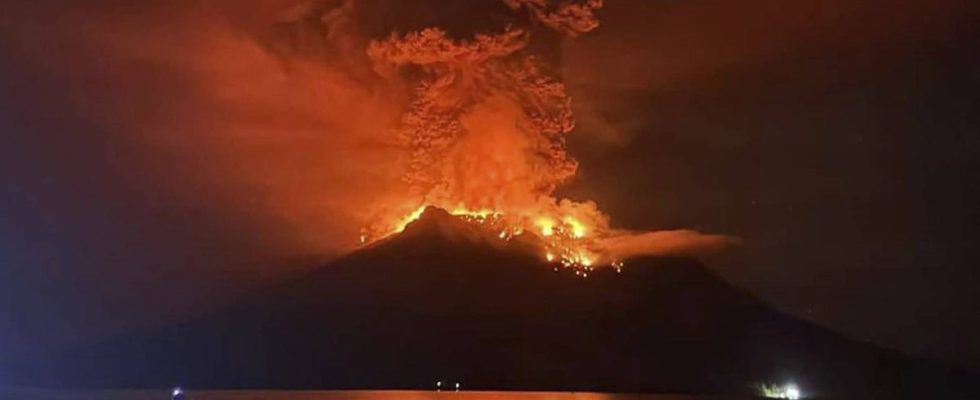Published on
Updated
Reading 3 min.
in collaboration with
Dr Gérald Kierzek (Medical Director)
Panic in Indonesia. For 48 hours, the Ruang volcano has been blowing its fury and issuing a tsunami alert. How can we protect ourselves and organize ourselves in such an outburst? Dr. Gérald Kierzek, emergency physician, gives us his advice.
Since Tuesday April 16, Indonesia has lived to the rhythm of the Ruang volcano which erupted. But its activity doubled in intensity during the night from Wednesday to Thursday, pushing the authorities to raise the alert level to the highest and order the evacuation of thousands of residents.
On site, a scene of apocalypse and the threat of a tsunami
The images flowing in are spectacular. The volcano located in the north of the archipelago which spewed lava all night presented this Thursday morning an immense column of smoke in which numerous lightning bolts formed. Ruang has experienced five eruptions since Tuesday and projected a cloud of ash more than a kilometer high into the sky, causing the need to evacuate the closest 11,000 residents on neighboring islands.
But authorities are now worried about a possible risk of a tsunami.
“Residents of Tagulandang Island, especially those residing near the beach, should be on alert for the risk of incandescent rock projections, fiery clouds and tsunami caused by the collapse of the volcano mass in the sea”declared Wednesday Hendra Gunawan, director of the Indonesian volcanology agency, in a press release.
The emergency services are now mobilized and ready to react.
Clouds, particles dangerous to health
Lava is not the first threat when it comes to eruptions. The particles and smoke projected by the crater are the most invasive. As explained by Dr. Gérald Kierzek, emergency physician and medical director of Doctissimo, but also author of Have good reflexes. (Fayard, November 2016)
“Several human health risks exist depending on particle concentration, duration of exposure and individual health status.”
- Breathing problems : Fine particles present in volcanic ash can penetrate deep into the respiratory tract when inhaled. This can cause respiratory tract irritation, lung inflammation, asthma exacerbations, and other breathing problems.
- Skin irritations : Direct contact with volcanic ash may cause skin irritation, especially in people with sensitive skin. This may manifest as redness, itching and rash.
- Eye problems: Volcanic ash can also irritate the eyes, causing redness, itching, burning and watering. Prolonged exposure to particles can lead to conjunctivitis or other eye infections.
- Long-term effects: Although the short-term effects of exposure to volcanic ash are often the most visible, there may also be long-term health effects, particularly in people with repeated or prolonged exposure. This can include chronic breathing problems, lung disease and other complications.
Faced with such a situation, the doctor reminds us of the measures to be applied urgently (in addition to following the evacuation instructions obviously):
- Wear a face mask : Using an N95 face mask or appropriate respirator can help filter fine particles and reduce inhalation of volcanic ash.
- Cover your skin : Wearing long-sleeved clothing, pants and protective eyewear can help reduce direct contact with ashes and protect skin and eyes.
- Stay inside : Limit the time spent outdoors during a volcanic eruption and stay indoors as much as possible, closing windows and doors to keep ash out.
- Clean up the ashes : Regularly cleaning ashes from exterior surfaces, roofs, gutters and vehicles can help reduce exposure.
Tsunami alert: 3 levels of precaution
Concerning the possible tsunami, populations must respect the published alerts. In France, there are 3 of them, yellow, orange or red.
- Yellow level : call for vigilance in the event of an earthquake at orange level in the area. This involves warning the authorities that a strong earthquake has occurred, that it may have been felt by the population, and that it is necessary to be vigilant of any abnormal marine phenomena including the rapid retreat of the sea, the strong currents;
- Orange level : the necessary actions are the evacuation of the seaside, beaches, shores, ports, coastal roads less than 3m above sea level, and a ban on swimming and passenger transshipment;
- Red level : this is an orange level plus rapid vertical evacuation (on high points, in hills, in concrete buildings, or far inland outside and far from estuaries).
